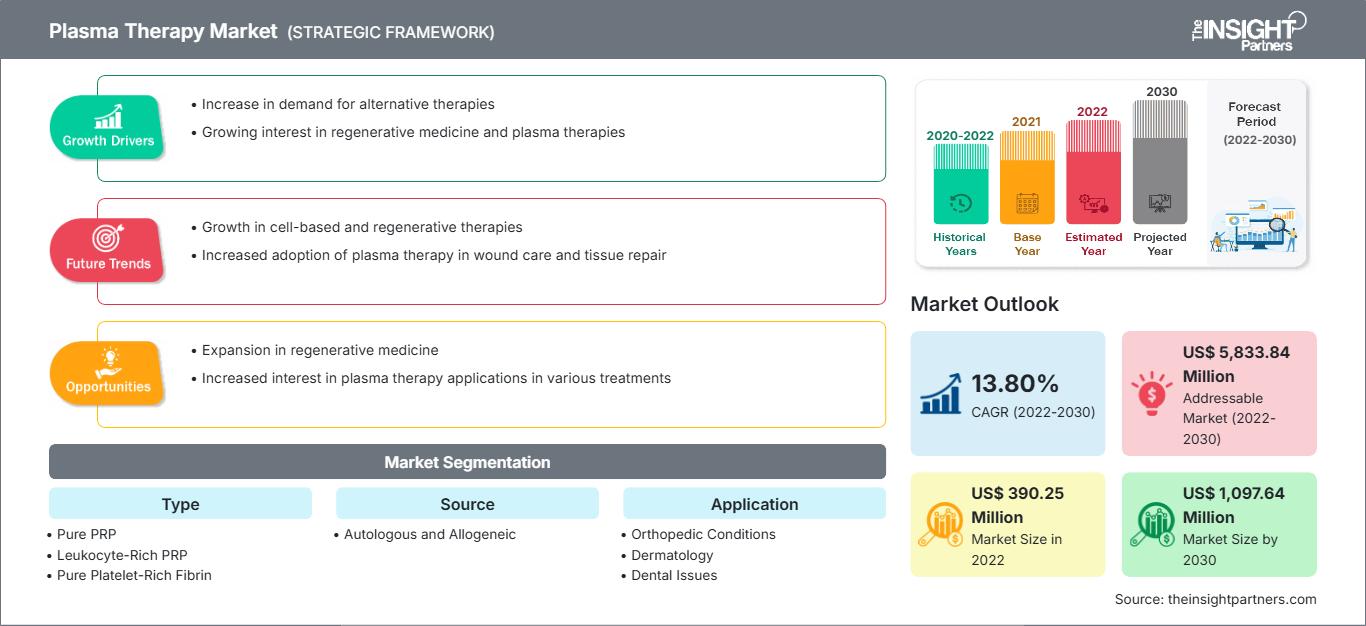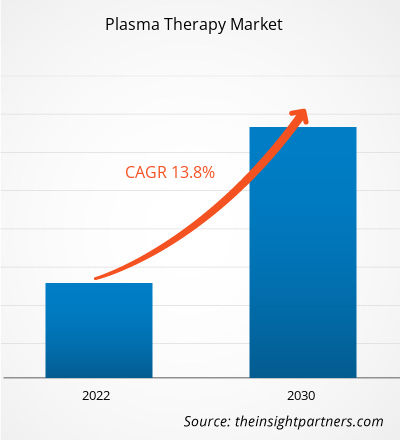[Rapport de recherche] La taille du marché de la thérapie plasmatique devrait passer de 390,25 millions de dollars américains en 2022 à 1 097,64 millions de dollars américains d'ici 2030 ; le marché devrait enregistrer un TCAC de 13,80 % de 2022 à 2030.
Point de vue de l'analyste
L'analyse du marché de la thérapie plasmatique explique les moteurs de croissance tels que l'augmentation des cas de troubles orthopédiques chez les personnes, en particulier dans la population gériatrique ; le nombre croissant de blessures articulaires et musculaires chez les athlètes et la demande croissante de procédures cosmétiques mini-invasives. De plus, la personnalisation des thérapies plasmatiques en fonction des besoins des patients Les besoins en plasma devraient introduire de nouvelles tendances sur le marché entre 2022 et 2030.
La thérapie plasmatique, également appelée thérapie au plasma riche en plaquettes (PRP), implique l'utilisation du plasma sanguin obtenu auprès de personnes ayant guéri avec succès d'une maladie pour traiter diverses affections et favoriser le processus de guérison. Les traitements PRP trouvent des applications en orthopédie pour le traitement des blessures articulaires, en dermatologie pour les procédures de rajeunissement de la peau et en dentisterie pour la réparation des tissus. Les facteurs de croissance présents dans le PRP stimulent efficacement la régénération des tissus, accélérant ainsi la guérison des blessures ou améliorant les mécanismes impliqués dans les procédures esthétiques.
Aperçu du marché
Augmentation des cas de troubles orthopédiques et Les blessures musculaires et l'utilisation croissante du PRP dans les procédures esthétiques alimentent le marché de la thérapie par plasma
Selon les statistiques publiées par l'Organisation mondiale de la santé (OMS) en 2023, environ 528 millions de personnes dans le monde vivaient avec de l'arthrose (OA) en 2019, ce qui représente une augmentation de 113 % depuis 1990. Un article publié dans PubMed Central en décembre 2020 indique que l'utilisation du PRP offre un potentiel de réparation tissulaire en raison de l'abondance de facteurs de croissance et de cytokines dans ce plasma, qui sont essentiels pour initier et moduler les microenvironnements régénératifs des tissus mous et durs. La thérapie PRP peut être utilisée dans la guérison des fractures osseuses ; des lésions ligamentaires, musculaires et tendineuses ; des lésions des nerfs périphériques ; des lésions du cartilage articulaire ; et de l'arthrose. Il existe donc une forte demande de thérapies plasmatiques dans les interventions orthopédiques et de réparation tissulaire.
De plus, le PRP est utilisé en chirurgie esthétique pour le rajeunissement cutané, la lutte contre le vieillissement et d'autres interventions esthétiques. Sur 73 études évaluées dans une revue publiée dans PubMed Central en novembre 2021, 45 se sont concentrées sur la monothérapie par PRP, tandis que 35 études ont examiné les effets du PRP en association avec le microneedling. Par conséquent, les thérapies ont été bien tolérées et adaptées à tous les phototypes. Des résultats thérapeutiques positifs ont été identifiés pour diverses affections, notamment le rajeunissement de la peau, la révision des cicatrices, l'alopécie, les troubles pigmentaires, le lichen scléreux, la neuropathie périphérique induite par la lèpre, le psoriasis en plaques et les troubles des ongles.
Par conséquent, l'utilisation du PRP en chirurgie esthétique contribue à la croissance du marché de la thérapie plasmatique.
Tendance future
Les options de personnalisation pour introduire des thérapies centrées sur le patient émergent comme tendance future sur le marché de la thérapie plasmatique
La thérapie plasmatique personnalisée implique la personnalisation des thérapies plasmatiques pour répondre aux besoins des patients en fonction de facteurs tels que leurs conditions médicales spécifiques et leur constitution génétique. Les efforts de personnalisation sont axés sur l'amélioration de l'efficacité de la thérapie plasmatique en adaptant la composition de composants tels que les anticorps et les protéines pour traiter plus efficacement l'état de santé spécifique du patient. Les chercheurs et les professionnels de santé mettent à profit leur expertise pour trouver des moyens d'adapter la thérapie plasmatique à des pathologies spécifiques, telles que les maladies auto-immunes, les maladies infectieuses et les cancers rares. Des entreprises comme Regenexx et Bridging Biosciences proposent du PRP hautement pur et concentré, personnalisable pour éliminer les incohérences dans la cicatrisation des lésions tissulaires et la régénération cellulaire. L'USA Medical Research Institute, au Texas, propose la thérapie PRP TruDose, qui contient des doses thérapeutiques personnalisées pour le traitement de diverses douleurs chroniques liées aux troubles musculo-squelettiques, au lupus, aux intolérances alimentaires, à la maladie de Lyme et à de nombreuses affections dégénératives.
Vous bénéficierez d’une personnalisation sur n’importe quel rapport - gratuitement - y compris des parties de ce rapport, ou une analyse au niveau du pays, un pack de données Excel, ainsi que de profiter d’offres exceptionnelles et de réductions pour les start-ups et les universités
Marché de la thérapie plasmatique: Perspectives stratégiques

-
Obtenez les principales tendances clés du marché de ce rapport.Cet échantillon GRATUIT comprendra une analyse de données, allant des tendances du marché aux estimations et prévisions.
Segmentation et portée du rapport
Informations basées sur le type
En fonction du type, le marché de la thérapie plasmatique est segmenté en PRP pur, PRP riche en leucocytes, fibrine riche en plaquettes pure et fibrine riche en leucocytes. Le segment de la fibrine riche en plaquettes pure détenait la plus grande part de marché en 2022 et devrait enregistrer le TCAC le plus élevé entre 2022 et 2030. Le PRP riche en leucocytes (LR-PRP) est un type de PRP qui présente une concentration de neutrophiles (globules blancs) plus élevée que le niveau de base. Il est généralement associé à des effets pro-inflammatoires. Cependant, dans certains cas, le LR-PRP peut être bénéfique pour stimuler l'inflammation dans le corps et indiquer une affection chronique telle qu'une tendinopathie.
Informations basées sur les sources
Le marché de la thérapie plasmatique, selon la source, est divisé en deux catégories : autologue et allogénique. Le segment autologue a dominé le marché en 2020.
Informations basées sur les applications
Le marché de la thérapie plasmatique, par application, est segmenté en affections orthopédiques, dermatologie, problèmes dentaires, etc. Le segment dermatologique détenait la plus grande part de marché en 2022.
Informations basées sur l'utilisateur final
En termes d'utilisateur final, le marché de la thérapie plasmatique est classé comme suit : hôpitaux et cliniques, instituts de recherche, centres de chirurgie ambulatoire (CVA), etc. Le segment hospitalier détenait la plus grande part du marché en 2022 et devrait enregistrer le TCAC le plus élevé du marché entre 2022 et 2030.
Aperçu régional du marché de la thérapie plasmatique
Les tendances régionales et les facteurs influençant le marché de la thérapie plasmatique tout au long de la période de prévision ont été analysés en détail par les analystes de The Insight Partners. Cette section aborde également les segments et la géographie du marché de la thérapie plasmatique en Amérique du Nord, en Europe, en Asie-Pacifique, au Moyen-Orient et en Afrique, ainsi qu'en Amérique du Sud et en Amérique centrale.
Portée du rapport sur le marché de la thérapie plasmatique
| Attribut de rapport | Détails |
|---|---|
| Taille du marché en 2022 | US$ 390.25 Million |
| Taille du marché par 2030 | US$ 1,097.64 Million |
| TCAC mondial (2022 - 2030) | 13.80% |
| Données historiques | 2020-2022 |
| Période de prévision | 2022-2030 |
| Segments couverts |
By Type
|
| Régions et pays couverts |
Amérique du Nord
|
| Leaders du marché et profils d'entreprises clés |
|
Densité des acteurs du marché de la thérapie plasmatique : comprendre son impact sur la dynamique commerciale
Le marché de la thérapie plasmatique connaît une croissance rapide, portée par une demande croissante des utilisateurs finaux, due à des facteurs tels que l'évolution des préférences des consommateurs, les avancées technologiques et une meilleure connaissance des avantages du produit. Face à cette demande croissante, les entreprises élargissent leur offre, innovent pour répondre aux besoins des consommateurs et capitalisent sur les nouvelles tendances, ce qui alimente la croissance du marché.

- Obtenez le Marché de la thérapie plasmatique Aperçu des principaux acteurs clés
- Analyse historique (2 ans), année de base, prévision (7 ans) avec TCAC
- Analyse PEST et SWOT
- Taille du marché Valeur / Volume - Mondial, Régional, Pays
- Industrie et paysage concurrentiel
- Ensemble de données Excel
Rapports récents
Témoignages
Raison d'acheter
- Prise de décision éclairée
- Compréhension de la dynamique du marché
- Analyse concurrentielle
- Connaissances clients
- Prévisions de marché
- Atténuation des risques
- Planification stratégique
- Justification des investissements
- Identification des marchés émergents
- Amélioration des stratégies marketing
- Amélioration de l'efficacité opérationnelle
- Alignement sur les tendances réglementaires






















 Obtenez un échantillon gratuit pour - Marché de la thérapie plasmatique
Obtenez un échantillon gratuit pour - Marché de la thérapie plasmatique